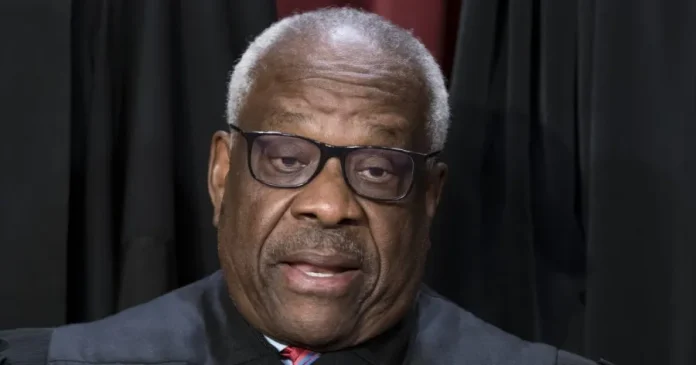The U.S. Supreme Court is the pinnacle of the judicial system in the United States representing justice and truth. Recently, however, rumors against Justice Clarence Thomas have rekindled such a debate raging on ethics accountability, and judiciary transparency. They not only revolve around controversies surrounding Justice Clarence Thomas’s move but also show systemic flaws concerning how the judicial mechanism is kept in check.
Charge Against Clarence Thomas
The accusations against Supreme Court Justice Clarence Thomas were filed initially to attract the nation’s attention since they contained stories of his luxury travel being paid for by GOP megadonor Harlan Crow. Such travel like private jet flights and lavish vacations he took are not filed in financial disclosures. Thomas insisted that Crow is a close personal friend, and under prior guidelines, such trips weren’t required to be disclosed.
The defense has been assailed by Democrats and other ethics watchdogs who argued that it vitiated the court’s integrity if such benefits were not declared. This was most vehemently argued by Oregon Senator Ron Wyden, a Democrat and Democratic chairman of the Senate Finance Committee, who spearheaded the moves to strengthen the ethics rules that increased transparency in justices’ dealings within the Supreme Court.
Judicial Conference Refuses DOJ Referal
Under increasing pressure, the U.S. Judicial Conference announced it would not refer the allegations against Justice Thomas to the Department of Justice. The Judicial Conference is responsible for federal court policy. U.S. District Judge Robert Conrad explained he was uncertain whether the law permits such a referral for a Supreme Court justice, as he serves as secretary of the Judicial Conference.
Yet this statement by Judge Conrad has highlighted the worst concerns of several regarding no accountability mechanism with the highest courts. For this appointment for the appointment of a special counsel to investigate a letter from the Democratic Senators did precede Attorney General Merrick Garland a day before the Judicial Conference decides on this very matter.
There is an even larger call that the reforms must continue to be for ethical reforms.
The scandal has resurrected calls for ethics reform in the ethics governing Supreme Court justices. Critics contend that the current system lacks transparency and accountability needed to build public trust. Federal judges follow a code of conduct, whereas Supreme Court justices have not had a code of ethics until 2023 when they adopted their first ever.
This new code has been criticized in that it does not contain any mechanism to ensure compliance. It is, after all, Justice Thomas’s concurrence to abide by the new requirements for reporting on gifts and trips underlines the necessity of a clear framework that compels compliance.
Also read: Why is Lululemon So Expensive? The Secrets Behind the Luxury
According to Gabe Roth, executive director of Fix the Court, a procedure that brings transparency in the investigative process about allegations of judicial misconduct is long overdue. “The Judicial Conference’s failure to act underlines the imperative for Congress to establish a new oversight mechanism,” said Roth.
Justice Jackson
Justice Clarence Thomas is not a singular circumstance of a justice who is being examined over some disclosures that occur relating to finance. For instance, Jackson’s husband was missing consulting income in her filing at the reporting period’s opening. She amended her disclosure and agreed to the newly enhanced reporting requirements.
With Thomas’s and Jackson’s different responses to the calls for setting clear, enforceable rules to be followed by all justices, calls for such setting have increased.
The lack of defined measures for accountability makes the credibility and trustworthiness of the court dubious.
Political and Public Reactions
It seems that the controversies against Justice Thomas have polarized public opinion, as supporters feel the attacks are political in nature and thus were only aimed to discredit a stalwart conservative of the court, but the opposition sees this within the larger trajectory of ethical failure aimed at rendering judicial practice appear non-neutral.
This split is also visible in the Congress. Forcing more accountability on the judiciary, bills were opposed very vociferously. Republican senators, generally speaking, have included Thomas as an ally and a champion; however, the Democrats have been demanding sterner ethical standards.
The media have played a major role in the public discourse. Investigative reporting brought financial ties Thomas had forged to light and has generated a lot of discussion on the topics of wealth, politics, and ethics of the judiciary.
Broader Implications for the Judiciary
The scandal involving Justice Thomas highlights systemic issues in ensuring accountability within the judiciary. Unlike other branches of government, the Supreme Court functions with considerable independence, which is essential to its function but also leaves a gap in oversight.
Advocates for reform argue that this gap must be addressed to preserve the integrity of the court. “No one should be above the law, especially those who are tasked with interpreting it,” Whitehouse said.
Looking Ahead
Discussion on the issues of ethics violations perpetrated by Justice Thomas is slowly steering the conversation on individual accountability, towards systemic change. Advocacy group Fix the Court is pushing toward comprehensive changes regarding transparency, the impartiality expected of the institution, and then public trust in the judiciary.
Such accusations have long shadowed the tenure of Justice Thomas. He may accept the requirements for more reporting, but critics claim that this is not enough to address the issues broader in scope.
A Time of Settlement
This is the biggest moment in the history of the Supreme Court and the general judiciary. Allegations of ethics violations coupled with a lack of mechanisms of enforcement have heightened the call for reform.
Such an action will prevent compromising the integrity of the highest court in the land. Confidence in the judiciary can only be increased if the judicial system upholds justice, fairness, and accountability.
Conclusion
The case against Justice Clarence Thomas is an example of the great challenge for the U.S. judiciary. But one thing is sure stakes are too high to ignore. To fulfill its role as the guardian of the Constitution, the Supreme Court needs to be at its best ethically.
For persistence in inquiry, the judiciary must rise and, express even greater commitment to openness, accountability, and allegiance to the rule of law, be that shining cornerstone in the American political firmament.








